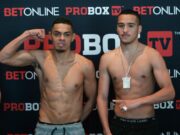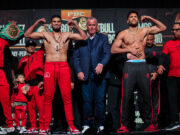
By Norm Frauenheim –
The deal is done, all nine figures of it, without any chance that Canelo Alvarez will face David Benavidez over the next year.
It’s not a surprise. It’s more of a pattern. Months ago, Canelo and his trainer, Eddy Reynoso, were clear that their plans did not include Benavidez.
If not now, when?
It’s an unanswered question. The pressure is on Benavidez to provide an answer. Canelo put it there, squarely on his young shoulders, in interviews after Canelo’s May 7 date with light-heavyweight Dmitry Bivol on May 7 at Las Vegas’ T-Mobile Arena was formally announced Wednesday.
Canelo repeated his mantra about his pursuit of history. He suggested there was no chance at making some against Benavidez or Jermall Charlo. He suggested that they needed to fight each other.
Mostly, he said they needed to bring more to the table in terms of legacy, a word that is at the cornerstone of the marketing for the Canelo-Bivol bout, the first in a rich Matchroom deal expected to lead to a third Canelo fight with Gennadiy Golovkin.
On the virtual fight poster, it says “Legacy Is Earned.’’ In social media, it comes with a hashtag, #legacyisearned. Intentional or not, the message to Benavidez and Charlo is that they haven’t earned enough of it.
“They have nothing to offer,’’ Canelo told reporters after the Bivol bout was announced at a news conference in San Diego. “I just want to make history, and they have nothing to offer me.’’
Canelo’s kind of history, of course, is attached to more than a hashtag. There’s a dollar sign, a very big one. According to some reports, the deal for perhaps three fights is worth $160 million.
That’s a lot of legacy, enough to be a powerful factor in any calculation of the risk-to-reward ratio.
Floyd Mayweather Jr. perfected it.
Canelo learned it.
It’s impossible to understand Canelo’s career without his loss to Mayweather on Sept. 14, 2013 at Vegas’ MGM Grand. The loss was a lesson, on both sides of the ropes for Canelo, who was 23 – two years younger than Benavidez – when he lost a decision to Mayweather.
In the eight-plus years since then, Canelo has evolved as a boxer. And a businessman. He has succeeded Mayweather at the top of the game because of what he learned from him.
There are two fundamentals: Knowing who to fight. And when to fight him.
It’s no coincidence that Canelo has waited until GGG turned 40 before a second rematch of their two controversial bouts, the first a draw and the second a Canelo victory by majority decision.
Assuming GGG beats Ryota Murata on April 9 in Japan, he’ll face Canelo, still well within his prime. He’ll turn 32 on July 18. Insert the respective ages to the risk-to-reward equation, and GGG looks less risky than a 25-year-old Benavidez, especially for a payday that could exceed $50 million.
Put it this way: Who would you fight? Dumb question. It’s GGG every time.
It’s hard to see how the emerging Benavidez ever gets included in Canelo’s application of the risk-reward ratio. Benavidez, expected to fight Canadian David Lemieux in May perhaps in hometown Phoenix, is just entering his prime. He’ll be 30 in five years. By then, Canelo might have moved from the gym to the golf course for good.
Benavidez might be to Canelo what Antonio Margarito was to Mayweather. Mayweather never fought Margarito. That’s not because he couldn’t beat him. He could. He probably would have. But it would have been a very tough fight. Margarito was tough and aggressive. He was dangerous. Manny Pacquiao beat him, scoring a one-sided decision in November 2010 on the Dallas Cowboys’ home field in Arlington, Tex.
But Pacquiao got hurt by a huge body shot midway through the bout from Margarito. It took something from Pacquiao. The Filipino great was never quite the same fighter, so relentless and fearless early in his pro career.
Pacquiao won. But he paid a price. Mayweather wouldn’t go there. A likely victory wasn’t worth the potential cost.
It looks as if Canelo sees Benavidez the same way. Canelo would probably beat him. But Benavidez’ size, high volume of punches and relentless pursuit could take a toll. The risk is a steep price, one not worth it on a scale that has rewarded Canelo with Mayweather-like money.
























